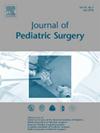Tracheal work of breathing in neonates with tracheoesophageal fistula before and after surgical repair via computational fluid dynamics assessment
IF 2.5
2区 医学
Q1 PEDIATRICS
引用次数: 0
Abstract
Introduction
Tracheoesophageal fistula (TEF), often occurring with esophageal atresia (EA), presents significant respiratory challenges in neonates. Neither the effect of EA/TEF, nor the effect of post-surgical complications such as tracheomalacia, on respiratory effort has been previously quantified. This study calculates the tracheal resistive component of work of breathing (TR-WOB) to quantify breathing effort pre- and post-surgical repair of EA/TEF. The primary objective of this study was to calculate the TR-WOB before and after surgical repair and compare it to normal values.
Methods
Five neonates with EA/TEF underwent ultrashort echo time (UTE) MRI before and after surgical repair. Virtual airway models were segmented from the MRI, with airway motion calculated via registration of respiratory-gated MRI. Computational fluid dynamic (CFD) simulations based on these virtual airways modeled patient-specific airflow calculated TR-WOB. Tracheal cross-sectional area (CSA) was quantified to reveal the relationship between airway anatomy and TR-WOB.
Results
Mean TR-WOB decreased from 686 ± 1013 J/day pre-surgery to 116 ± 159 J/day post-surgery (p = 0.299, Cohen's d = 0.301). In some subjects, TR-WOB remained elevated post-surgically compared to healthy neonates reported in previous studies. Four of five subjects showed increased tracheal CSA post-surgery (23 % mean increase). A strong negative correlation was found between average CSA and TR-WOB post-surgery (ρ = −0.90, p = 0.037), suggesting anatomical improvements reduce breathing effort.
Conclusion
Surgical repair of EA/TEF reduces TR-WOB, but TR-WOB remains abnormally high in some patients. CFD-based assessments offer a quantitative tool for identifying neonates who may benefit from additional interventions to reduce TR-WOB during their EA-TEF repair.
Level of Evidence
4 Case Series.
计算流体力学评估新生儿气管食管瘘手术修复前后的呼吸功。
气管食管瘘(TEF)常与食管闭锁(EA)一起发生,给新生儿带来严重的呼吸挑战。无论是EA/TEF的影响,还是术后并发症(如气管软化)对呼吸力的影响,以前都没有被量化。本研究通过计算呼吸功的气管阻力分量(TR-WOB)来量化EA/TEF手术前后的呼吸功。本研究的主要目的是计算手术修复前后的TR-WOB,并将其与正常值进行比较。方法:对5例新生儿EA/TEF手术前后行超短超声时间(UTE) MRI检查。从MRI中分割虚拟气道模型,通过呼吸门控MRI配准计算气道运动。基于这些虚拟气道的计算流体动力学(CFD)模拟模拟了患者特定的气流,计算了TR-WOB。量化气管横截面积(CSA),揭示气道解剖与TR-WOB的关系。结果:平均TR-WOB由术前686±1013 J/d降至术后116±159 J/d (p=0.299, Cohen’s d=0.301)。在一些受试者中,手术后TR-WOB与先前研究中报道的健康新生儿相比仍然升高。5名受试者中有4名术后气管CSA增加(平均增加23%)。术后平均CSA与TR-WOB呈显著负相关(ρ=-0.90, p=0.037),提示解剖结构改善可减少呼吸费力。结论:手术修复EA/TEF可降低TR-WOB,但部分患者TR-WOB仍异常高。基于cfd的评估提供了一种定量工具,用于识别在EA-TEF修复期间可能受益于额外干预以减少TR-WOB的新生儿。证据级别:4个案例系列。
本文章由计算机程序翻译,如有差异,请以英文原文为准。
求助全文
约1分钟内获得全文
求助全文
来源期刊
CiteScore
1.10
自引率
12.50%
发文量
569
审稿时长
38 days
期刊介绍:
The journal presents original contributions as well as a complete international abstracts section and other special departments to provide the most current source of information and references in pediatric surgery. The journal is based on the need to improve the surgical care of infants and children, not only through advances in physiology, pathology and surgical techniques, but also by attention to the unique emotional and physical needs of the young patient.

 求助内容:
求助内容: 应助结果提醒方式:
应助结果提醒方式:


